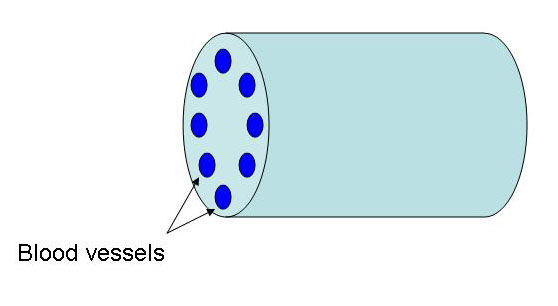- Search the literature to collect data about a fast hunter
such as wild dog, leopard, or lion.
Find mass M, top speed Ut, length of leg L,
length of step while foot is on the ground S,
period
 (either from T = 1/n
where n is the number of steps per second,
or from the distance
(either from T = 1/n
where n is the number of steps per second,
or from the distance  between
two imprints of the feet on the ground:
between
two imprints of the feet on the ground:
 ,
duration
,
duration  of the hunt, or the range
of the hunt, or the range  .
Treat the motion of the rear leg like simple harmonic motion
where the position of the foot relative to the vertical is
.
Treat the motion of the rear leg like simple harmonic motion
where the position of the foot relative to the vertical is
 , where A = S/2 is the amplitude,
and
, where A = S/2 is the amplitude,
and
 is the velocity of the foot.
The maximum foot velocity is
is the velocity of the foot.
The maximum foot velocity is
 ,
the instantaneous acceleration of the foot is
,
the instantaneous acceleration of the foot is
 ,
and the maximum foot acceleration is
,
and the maximum foot acceleration is
 .
.
- Assuming that the maximum acceleration of the foot
is equal to the maximum acceleration of the body, find
the acceleration time t1 needed to reach top speed Ut = a t1.
- Determine the speed-up distance s1
(similar to the free fall distance
 ).
).
- Calculate the kinetic energy K
which the animal attains at top speed.
- Assuming that K was obtained by the application of
an average force F acting during the time t1
or over the distance s1,
the energy equation reads
K = F x s1,
from which F can be found.
- Find the total energy expense of the hunt,
 and express it in mass of body fat burned,
taking into account a reasonable inefficiency of
converting the body fat into muscle fuel.
and express it in mass of body fat burned,
taking into account a reasonable inefficiency of
converting the body fat into muscle fuel.
- Determine the impact speed U0.
- Calculate the deceleration (negative acceleration)
of the the boy's center of mass during landing,
and determine the average force
on the soles of his shoes during impact.
- The girl (Mg = 65 kg) lands on the rock,
but in order to reduce the impact force she lands with soft knees
and moves her center of gravity relative to her feet
by
 m as she lands.
What is the average impact force
on the soles of her feet during the landing?
m as she lands.
What is the average impact force
on the soles of her feet during the landing?

- Determine the surface area A of the gills
that contributes to the diffusion exchange of oxygen.
- Calculate the diffusion flow rate of oxygen
 [molecules/sec] into the gills.
(See Sect. 4.1.3; assume first that
the blood returning from the body into the gills
is completely deoxygenated.)
[molecules/sec] into the gills.
(See Sect. 4.1.3; assume first that
the blood returning from the body into the gills
is completely deoxygenated.)
- Use the relation between
 and
and  which is derived in Section 4.3.3
to determine the metabolic rate of the nudibranch.
which is derived in Section 4.3.3
to determine the metabolic rate of the nudibranch.
- Assuming that for these animals
 ,
determine the metabolic constant a.
,
determine the metabolic constant a.
- Look into the literature to assess if the assumption is reasonable
that the blood returning from the body into the gills
is completely deoxygenated. If not, how would this change your answers?